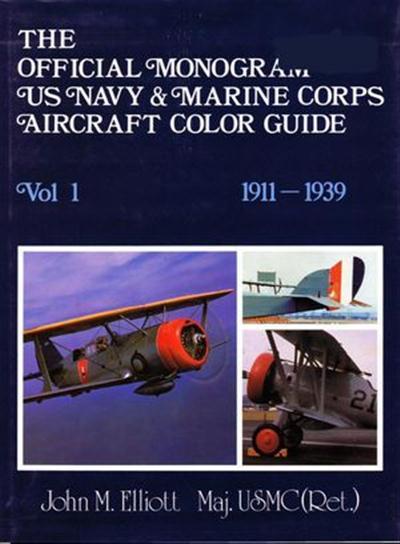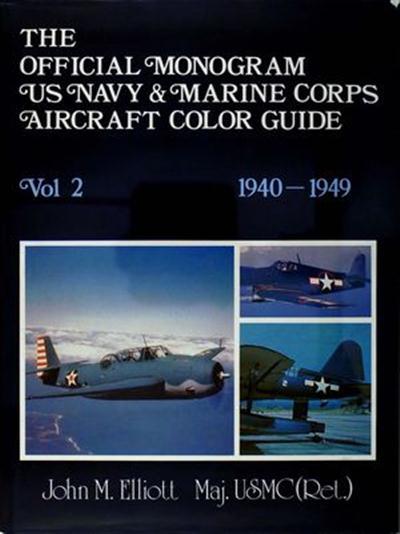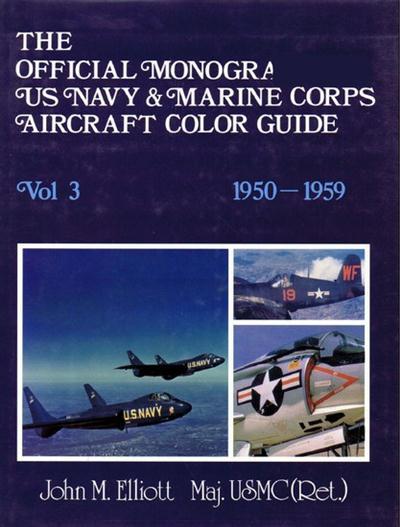Далеко не "свежачок", но, тем не менее, не такое уж бесполезное чтиво ... КМК

И даже в некоторой степени "монументальное", я бы сказал
 The Official Monogram U.S. Navy & Marine Corps Aircraft Color Guide Vol. 1: 1911-1939
The Official Monogram U.S. Navy & Marine Corps Aircraft Color Guide Vol. 1: 1911-1939
 Автор(ы):
Автор(ы): John M. Elliott Maj USMC (Ret)
Издательство: Monogram Aviation Publications
Год издания: 1987
ISBN: 0-914144-31-6
Язык: English
Количество страниц: 193
Формат: True PDF
Размер: 109 MB
The constantly changing colors and markings of US Navy aircraft reflect attempts at better recognition and operation, as well as the political and geographical influences affecting military actions.
Each has been adopted for aspecific purpose after thoughtful consideration by officers of the Fleet and the Bureau of Aeronautics in an attempt to standardize colors and markings throughout the naval service. The resultant regulations of the 1930's was an outstanding system for the time. After fifteen years of experimentation, the Navy developed by 1939 the most sophisticated system of military markings in the world. It worked well then because of the comparatively small size of naval aviation. However, the limited number of basic colors never would have been able to keep up with the explosive growth of the 1940's, so in a way it was a good thing that they could gracefully giv way to the wartime light gray of 1941.
It has taken sixty years for some of this information to be published, and most of the specific details and dates have not been available until now Major Elliott has done an outstanding job of assimilating a vast array of complicated and sometimes contradictory information, organizing it in a logical manner, and making it available for the first time. This is particularly gratifying to those of us who have lived through this period and yet often have been frustrated by an inability to explain what we have seen.
There is no doubt that this series of volumes will be the Masterwork on this subject and the basic reference work for all to benefit from.
William T. Larkins
The Official Monogram US Navy & Marine Corps Aircraft Color Guide, Vol 2: 1940-1949
 Название
Название: The Official Monogram US Navy & Marine Corps Aircraft Color Guide, Vol 2: 1940-1949
Автор(ы): John M. Elliott Maj USMC (Ret)
Издательство: Monogram Aviation Publications
Год издания: 1989
ISBN: 0-914144-32-4
Язык: English
Количество страниц: 194
Формат: True PDF
Размер: 132 MB
Throughout the history of Navy and Marine Corps aviation, the systems used to mark and paint aircraft have been extremely confusing. The lack of a complete history of the subject has resulted largely from the scattered condition of the reference collections. It has taken Jack Elliott a quarter-century to compile his multi-volume history of this subject. No one familiar with the subject matter and its documentation can be surprised that the project took so long. Volume I covers the years 1911 through 1939. Volume II covers the important ten years from 1940 to 1949 during which expansion and change were rules and not exceptions in the Navy and Marine Corps. The decade witnessed drastic changes in the systems the Navy and Marine Corps had used since the 1920's to mark and paint aircraft. The changes came so fast and were so numerous that their implementation was often left to the discretion of commanding officers and the availability of resources.
This second volume of the Elliott history documents these changes and offers explanations for them. The Official Monogram US Navy & Marine Corps Aircraft Color Guide, Vol. 2, 1940 to 1949, fills an important gap in this area of Navy and Marine Corps aviation history.
William J. Armstrong
Historian
Naval Air Systems Command
The Official Monogram US Navy & Marine Corps Aircraft Color Guide, Vol 3: 1950-1959
 Автор(ы)
Автор(ы): John M. Elliott Maj USMC (Ret)
Издательство: Monogram Aviation Publications
Год издания: 1991
ISBN: 0-914144-33-2
Язык: English
Количество страниц: 194
Формат: True PDF
Размер: 122 MB
It's been said that "There are two kinds of people in this world: those who believe there are two kinds of people, and those who don't." When it comes to aircraft color and markings, there really are only two kinds of people: Those like John Elliott who dig into all the details and get them straight - and the rest of us.
With this third volume in his series on US Navy and Marine Corps Aircraft Color and Markings, those of us having an interest in the subject will relate to the different volumes in different ways. By now, the first years, up through 1939, are a matter of academic interest to all but a very few who still care about the colorful naval aircraft that they flew or maintained during those years. With the tremendous expansion that began in 1940, and continued through World War II, there are a great number of us "who were there" in one way or another and translated our mostly modeling interest to the real thing. Enamored of this new relationship, color and markings interests were maintained mostly by the few - such as Bill Larkins who wrote the foreword for John's first volume. Among those who stayed in, joined the reserves, or either took up or reverted to modeling after the War, the interests in the subject were varied at the time - and continue to be. John's second volume is "the word" for all who reflect on this aspect of that period.
In my own case I have a particular identification with the fifties. For those years tied me to Naval Aviation, starting when recalled to active duty with my Reserve FASRON from my drafting board at Boeing. After a couple of different thrusts, direct involvement came with the engineering of the navy's aircraft - and opportunities to sample the product - as the Navy and Marines went through their major transition to the turbine engine - and supersonic fighter age. Through these years, there was not only a major transition in equipment (with the exception of old favorites like "Bugsmashers" and "Spads"), but the Sea Blue finish which most of us had grown up with in the real world gave way to gray, white, and something
called "day-glo" - though its generally weathered look soon reverted to more substantial orange. The patchwork colors - particularly at Reserve Bases - were nowhere better illustrated than the ReserVe FJ-2s at
Columbus, Ohio, when business took me to what was then a dynamic, forward-looking engineering group at North American Aviation's now long gone Columbus Division. I know there were Sea Blue, Orange and White, and Gray and White Furys seen on the line as TWA's Martin 202A or 404 landed or took off at Port Columbus - I'd like to think there were even one or two natural metal ones, but that's probably my memory playing tricks again.
Anyway, with another heavy, but colorful volume, John lays it all out for those who have an interest in naval aircraft generally, and a particular interest in those of the fifties. Color and markings data just doesn't get any better than this!
Harold Andrews
Aeronautical Engineer